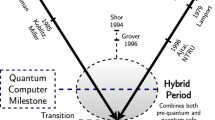Abstract
The construction and destruction of subliminal channel are important problems in the information hiding. The subliminal channel can send secret information without notice. Two subliminal-free methods named weak (strong) subliminal-free on public-key cryptosystem (PKC) are proposed in this paper using the combinatorial method. The first method can only free the subliminal information with any minor probability and the second can free all. Moreover, the “traitor problem” which is same as the model of the subliminal channel in PKC is given. Two subliminal channels are embedded inN-th degree truncated polynomial ring (NTRU) cryptosystem, and their subliminal-free methods are also be obtained by the action of surveillant.
Similar content being viewed by others
References
Simmons G J. The Subliminal Channel and Digital Signature [C]//Proc of Eurocrypt '84. Berlin Heidelberg: Springer, 1996:64–378.
Simmons G J. Subliminal Communication is Easy Using the DSA [C]//Advances in Cryptograph—Eurocrypt '93. Berlin Heidelberg: Springer, 1994:218–232.
Harn L, Guang G. Digital Signature with a Subliminal Channe[J].IEE Proc Comput Digit Tech, 1997,144(6):387–389.
Jan J K, Jan Y M. New Digital Signature with Subliminal Channels Based on the Discrete Logarithm Problem [C]//Proc. of 1999 International Workshop on Parallel Processing. Berlin Heidelberg: Springer, 1999:198–203
Zhang Jianhong, Wu Qainhong, Wang Jilin,et al. An Improved Signature Scheme with Subliminal Channel [J].Journal of the Graduate School of the Chinese Academy of Sciences, 2004,21(2):259–262 (Ch).
Feng Dengguo, Pei Dingyi. On the Realization of the Subliminal Channel Embedded into the SN-S Authentication System [C]//Advances in Cryptology—Chinacrypt' 98. Beijing: Science Press, 1998:94–97 (Ch).
Kuwakado H, Tanaka H. New Subliminal Channel Embedded in the ESIGN [J].IEICE Transactions on Fundamentals of Electronics, Communications and Computer Sciences, 1999,82(10):2167–2171.
Desmedt Y. Subliminal-Free Authentication and Signature [C]//Advances in Cryptology—Eurocrypt '88. Berlin: Springer, 1988:23–33.
Hoffstein J, Pipher J, Silverman J H. A Ring-Based Public Key Cryptosystem [C]//Proc of ANTS III, LNCS 1423. Berlin Heidelberg: Springer, 1998:267–288.
Tomescu I.Introduction to Combinatorics[M]. London: Collet's Press, 1975.
Author information
Authors and Affiliations
Corresponding author
Additional information
Foundation item: Supported by the National Natural Science Foundation of China (64073017) and the Ph. D. Initial Science Foundation of Guangzhou University (100101).
Biography: CAI Qingiun (1976-), male, Lecturer, Ph. D., research direction: information hiding, cryptography.
Rights and permissions
About this article
Cite this article
Qingjun, C., Yuli, Z. Subliminal channels in the NTRU and the subliminal-free methods. Wuhan Univ. J. Nat. Sci. 11, 1541–1544 (2006). https://doi.org/10.1007/BF02831816
Received:
Issue Date:
DOI: https://doi.org/10.1007/BF02831816




